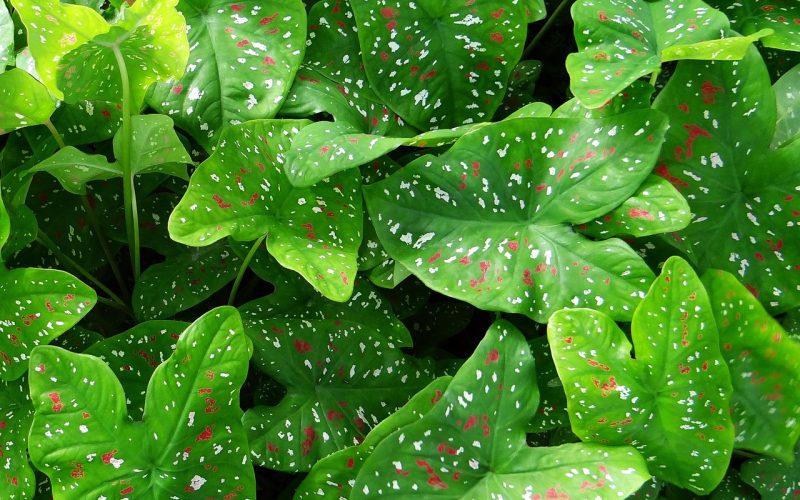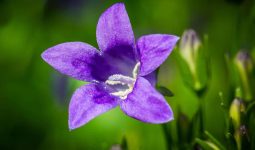The caladium houseplant (Caladium bicolor) accentuates any living space, thanks to its beautiful foliage.
This relatively low-maintenance plant also grows quickly and makes a great gift for any occasion.
But before you decide on the perfect caladium houseplant to bring home, it’s important to learn about their care and maintenance requirements.
This will help provide your new green friend with the environment it needs to thrive.
Read on to find out what it takes to grow and maintain the caladium houseplant to ensure your plant stays healthy, vibrant, and beautiful year-round.
Botanical Evaluation of Caladium Houseplant
The caladium houseplant is an unusual tropical plant available in various shades of green, pink, red, and orange.
Caladium houseplants are a family of shrubs and vines that includes over 1,000 species, mainly found in Central America and northern South America.
It’s also one of those flowering plants, making it an excellent choice for improving your home environment and adding color.
Caladiums are heat-loving tropical perennials that grow best in warm, humid climates. It’s also important to keep your caladium houseplants in a spot where they will get plenty of light but not too much direct sunlight.
It’s best to place them near an open window or on a porch where they can get indirect light most of the day.
Not leaving out that growing these amazing plants can also be quite profitable. Wonder why? Because you can sell them for various uses. Amazing.
There are many reasons why more and more people want to get into growing caladium plants at home. Read on further and learn more about how you can grow them!
How to Grow Caladium Houseplant?
These plants require well-draining, moist soil. They’re pretty easygoing regarding light requirements, preferring indirect sunlight and partial shade.
To keep their lush leaves intact, water caladium houseplants when they feel slightly dry on top of the soil.
In addition, be sure that you don’t over-water them or allow them to sit in wet soil for long periods.
Their foliage will suffer if you overwater your plants or don’t pay attention to how much water they’re getting.
Caladium houseplants are sensitive to root rot and other fungal diseases if they aren’t watered properly.
When it’s time to fertilize your caladium houseplant, use an all-purpose fertilizer.
Otherwise, stick with your standard general-purpose plant food found at local nurseries. Read on for more tips:
Right Soil for Caladium Houseplant
One of the most important things when caring for a caladium houseplant is picking out and properly watering the soil.
Plants that aren’t in soils that are optimal for them tend not only to look worse but also often die more quickly. This might be different if they were in an appropriate potting mixture.
Importantly, when picking an appropriate growing medium, you’ll need to know what type of growing environment you’re creating for your plant.
Fertile soils have lots of organic material and nutrients built up over time. Hence, they are best suited to plants that require high amounts of fertilizer, like succulents or cacti.
Right Amount of Sunlight
While it’s tempting to keep your caladium houseplant in direct sunlight, that can damage its health.
The potting soil should be moist but not soggy, so ensure you water it when it dries.
Be careful not to overwater and keep your plant away from heating vents or drafty windows. Also, if your home is on a well, don’t over-water; water may have harmful chemicals for plants.
These tropical plants flourish in temperatures between 75 and 80 degrees F (24-27 C). Given this, ensure you find an area of your house that is warm but not too hot.
Proper Watering
One of the most common reasons houseplants die is that they are over- or underwater.
Water the caladium houseplant when the soil is dry, and wait until you see the soil drying out before watering it again.
The color of your caladium’s leaves can indicate the water needed. If they start turning lighter in color, you need to water them more.
If they start turning darker in color, you need to water them less. In summary, do not overwater them, as this will rot their roots and cause them to die too quickly.
Adequate Moisture and Temperature
Caladium houseplants need well-draining soil. Water your caladium sparingly during dormancy in winter and allow it to dry out slightly between waterings. Too much moisture can cause rotting and brown spots on leaves.
Additionally, give your caladium houseplant plenty of light but not direct sun. Also, temperature levels should be monitored, between 55 and 75 degrees Fahrenheit (F).
A temperature change can cause leaf loss or damage in extreme cases.
You can purchase an artificial grow light if needed. However, be sure it is kept three or four inches away from the plant so it doesn’t burn its leaves.
Fertilizing Caladium Houseplant
Use an all-purpose plant fertilizer in spring, summer, and fall. For your caladium houseplant, use a water-soluble fertilizer at half-strength.
Water after fertilizing, but only if it needs it; don’t wait for signs of wilting or poor growth.
Stop fertilizing in winter when caladiums go dormant and keep them dry as much as possible.
Discontinue all feeding from December through February. Depending on your climate, you might need to reduce watering during these months.
Again, check your soil’s moisture level regularly throughout winter and resume normal watering once new growth begins in early spring.
Conclusion
While many people hunt for the cutest and most colorful flowering houseplants to add to their space, caladium houseplants often get passed over.
These beautiful tropical plants are perfect if you’re looking for something unique or elegant.
They spruce up your home in the fall and winter when other plants have stopped blooming, and the air outside isn’t as pleasant.
From growing tips to care instructions, this caladium houseplant guide will tell you everything you need to know about bringing one of these beautiful plants inside your home!
It’s easy to add a bit of color and style to your home without ever stepping into a retail store.
If you enjoy working with plants but don’t have the time or space to care for them, why not bring home a caladium houseplant?
Though they’re only available in select nurseries and garden stores, caladiums make an excellent addition to any household.
Just have the right conditions to care for them, and then you will enjoy!








